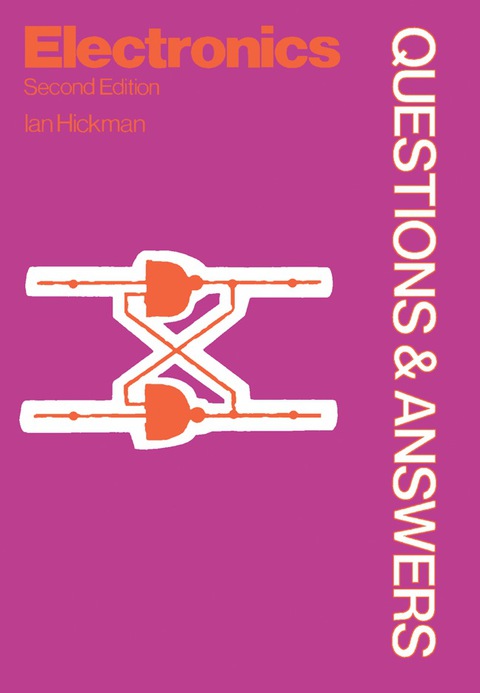Description
Efnisyfirlit
- Electronics
- Copyright Page
- Table of Contents
- Chapter 1. Introduction
- What is meant by ‘electronics’?
- What is an electron?
- What is an electric current?
- What is the difference between conductors and insulators?
- What is a semiconductor?
- Do currents flow only in metals and semiconductors?
- What causes a current to flow?
- How are e.m.f. and current related?
- What is the effect of combining resistances?
- What is internal resistance?
- What is the meaning of ‘matching’?
- Chapter 2. Waveforms, pulses, and signals
- What is the difference between d.c. and a.c.?
- What is the advantage of using a.c.?
- What is amplitude?
- What is frequency?
- What is wavelength?
- What is phase?
- Are there other types of current?
- Are pulses that simple?
- What other waveforms are there?
- What are harmonics?
- What is a signal?
- What is meant by ‘noise’?
- What is modulation?
- How do electromagnetic and sound waves compare ?
- What are ultrasonic waves?
- What is a transducer?
- Chapter 3.Components
- What is a resistor?
- What is an inductor?
- What is mutual inductance?
- How does a capacitor work?
- What is the unit of capacitance?
- What is meant by ‘time constant’?
- What is the effect of combining inductance and capacitance?
- What are passive components?
- What is a semiconductor diode?
- How is a diode used for rectification?
- What are ‘active components’?
- Are active components linear or non-linear?
- How does a transistor function?
- Is thai how all transistors work?
- What is a photo-electric cell?
- Are valves still used?
- Chapter 4. Amplification
- What are the main features of an amplifier?
- What frequencies can an amplifier such as that in Fig.38 handle?
- Will an amplifier like that shown in Fig. 38 drive a loudspeaker?
- Can you have a class B stage without crossover distortion?
- What kinds of distortion are encountered?
- What is meant by ‘bandwidth’?
- Why is decoupling necessary?
- What is meant by ‘feedback’, and how is it used?
- What is an emitter follower?
- What is the cascode circuit?
- Chapter 5. Generating signals
- What sort of signals can be generated?
- What is a crystal oscillator?
- Do all sinewave oscillators use tuned circuits?
- How is a squarewave produced?
- What effect has a ‘time constant’?
- How is a spike waveform produced?
- How is a triangular waveform produced?
- What other types of pulse circuit are there?
- Chapter 6. Radio and television
- What is the principle of radio?
- What modulation processes are used?
- What are the merits of FM?
- How are radio signals demodulated?
- What is the principle of television?
- How does the camera work?
- How is synchronisation achieved?
- How is the sound transmitted?
- What are the main sections of a TV receiver?
- How does remote-control TV work?
- What are the main features of a cathode-ray tube?
- How does colour television work?
- How can two colour signals be modulated on to the same subcarrier?
- How is a colour picture displayed?
- Chapter 7. Digital techniques
- What is the distinguishing feature of a digital circuit?
- What are some simple digital circuits?
- How are digital circuits connected together to do something useful?
- How does binary arithmetic work?
- How does a calculator work?
- How does a computer work?
- How is information stored?
- How does the computer communicate with the outside world?
- How can a computer monitor physical quantities such temperature and pressure?
- Do computers come in a range of sizes?
- How are computers programmed?
- Chapter 8. Electronic test and measurement equipment
- What are typical items of electronic testgear?
- Are digital techniques used in test equipment?
- What is a ‘bridge’?
- What are oscilloscopes used for?
- What is ATE?
- Chapter 9. Electronics in music and entertainment
- When did electronics become important in music and entertainment?
- What is hi-fi?
- What is Stereo?
- How does stereo work?
- What is ‘Quad’?
- How does a record player work?
- How does taperecording work?
- What is ‘Dolby’?
- What are digital recordings?
- How do systems like Ceefax work?
- How does an electronic organ work?
- What is a synthesiser?
- What other electronic techniques are used in music?
- Chapter 10. Other uses of electronics
- What is radar?
- How is microwave energy produced?
- What is special about the waveguide and the aerial?
- How is radar information information displayed?
- How is ultrasonic energy generated and used?
- How important are electronic techniques in medicine?
- Are radio techniques used in medicine?
- What other developments have there been?
- What is opto-electronics?
- Are there more opto-electronic devices?
- How does the laser work?
- Where is opto-electronics used?
- Index






Reviews
There are no reviews yet.